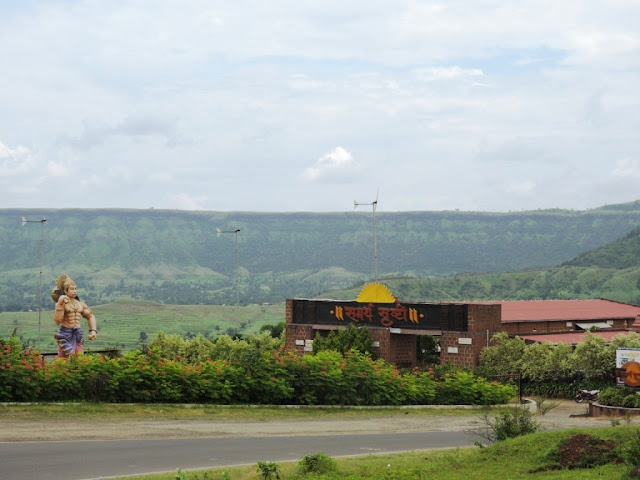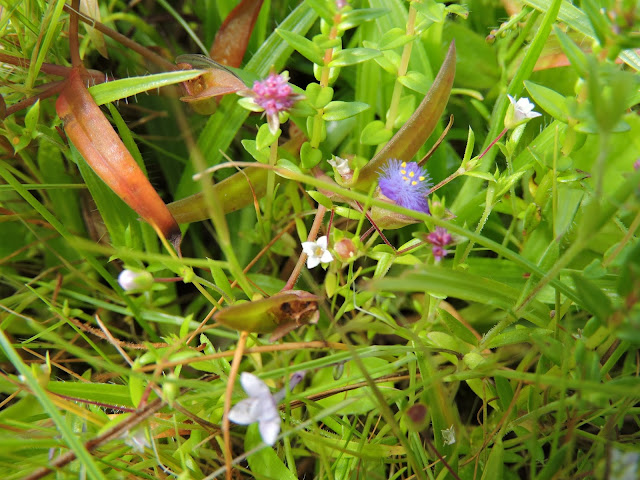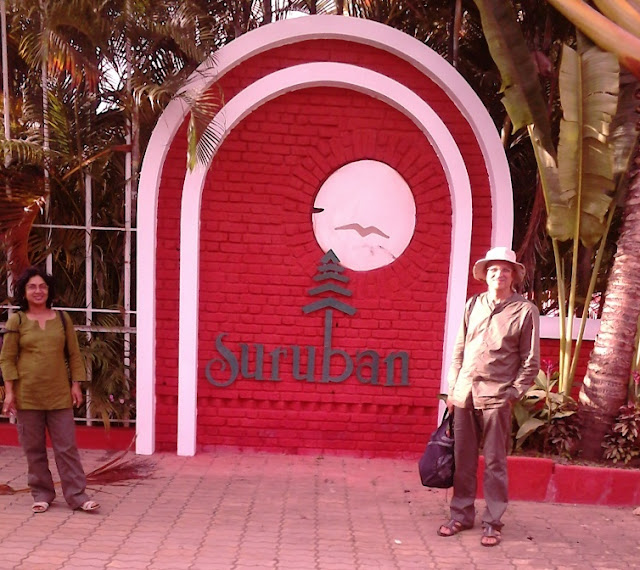 |
| Carpet of Eriocaulon sedgwickii and Utricularia purpurascens |
Anyone who ever gazed up
at the sky would agree that the universe is infinite.
At another level, however, it also exists on the infinitesimal
scale.
To appreciate this, we need to put our head down and try to reach that
level. And the prettiest place to do that is the famous plateau of Kaas, part
of the Western Ghats which have been declared as a UNESCO world natural heritage
area.
Travelling on the Mumbai Pune expressway, one is
amazed at how much greenery can sprout after the rains. The view may actually
remind some Englishmen of the rolling meadows of their countryside. It is as though nature decides to gives
herself a fresh green coat of paint in celebration of the celestial festival of
creation and germination.
The Satara valley, at 2400 feet, is surrounded by
tabletop mountains which look as though regular peaked mountains have been
sliced by a gigantic geological knife. Several of the mountaintops were converted into
Forts in the 16th century. The one overlooking Satara town is the
Ajinkyatara fort, once the pride of the Maratha kings, now host to a TV tower.
 |
| Ajinkyatara Fort |
One needs to head west of Satara town, past the
fort onto a good but narrow tar road to reach the Kaas plateau.
This rigde commands
breathtaking views of lakes on both sides overlooked by tabletop mountains.
Both sides of this road are covered with an unbelievable variety of grasses and
colourful flowers. Unfortunately, the entire stretch has now been plotted and
will, in the coming years, be covered with resorts.
After about an hour’s drive from town, one reaches
the designated plateau area, thankfully the property of the forest department. Though
fencing has been done to prevent “tourists” from trodding all over the flowers,
there is enough opportunity to explore the mindboggling miniflora taking root
on the laterite rock. At 3600 feet, it can actually get nippy in the mornings.
We were lucky to have excellent weather with
glorious mornings on both days with clouds playing hide and seek
intermittently.
 |
| Carpets of Impatiens balsamina |
While grass grows everywhere, there is a scientific
reason as to why this particular plateau is so uniquely blessed. The entire
plateau is made up of hard volcanic rock called laterite, which is highly porous
and in fact looks like a sponge. These pores tend to retain moisture and even
the slightest submillimetre layer of soil allows life to thrive. Large trees or
even bushes are unable to get a toehold.
The result is a seemingly unending
carpet of flowering grasses which have unhindered access to sunshine and we humans
have an unhindered view of the flowers!!
 |
| The Naughty Teachers |
At some strange level it reminded me of the coral
ecosystem. Shallow seas, plenty of sunshine bathing the reef polyps which
support the most astonishingly colourful array of tiny fish, existing in a
world of their own.
One is constantly reminded of the movie, Honey I
shrunk the kids. One square inch of grass seems to contain an unbelievable
variety of miniature flowers, some less than half a millimetre sized, each with
their own microcosm and appropriately sized insect pollinators.
To say that this place is a botanist’s paradise
would be an understatement. Even for those of us who have a somewhat scientific
temper and more than a passing interest in all things beautiful, Kaas is simply
mindblowing.
 |
| Asystasia dalzelliana - neelkanth |
 |
| Aponogeton satarensis - Ytura |
Out of the listed 1000 odd species, its’ quite
possible to log more than a hundred in one trip. To assimilate all the beauty
and information is the actual problem. Macrophotography is one way.
 |
| Add caption |
Every species seems to have its unique story,
either with a scientific basis of evolution and adaptation, or simply seeped in
legend. Either one, related so elegantly
in the field by our guides, Adesh, Mandar and Sweedle, is what really brings
science to life. How I wish botany was taught to me this way….
 |
| Begonia crenata male and female |
 |
| Ceropegia jainii |
 |
| Ceropegia vincifolia hirsuta |
 |
| Commelina maculata - Spotted Dayflower |
Seeing that most of the plants here have medicinal
value makes one marvel at the genius of our forefathers who created Ayurveda.
The story of Charaka being unable to find a single plant bereft of medicinal
value, on being given this task by his master, was truly mesmerizing.
 |
| Exacum pumilum Jambhali chirayat |
 |
| Impatiens dalzellii Yellow terda |
 |
| Neanotis lancifolia Taraguchha |
 |
| Pinda concanensis - Konkan Pinda |
 |
| Senecio bombayensis - Sonki |
 |
| Strobilanthes callosa Hill karvi |
 |
| Utricularia purpurascens Sitas tears |
Being amidst so many colourful flowers, one
couldn’t but help notice that there was no pervasive fragrance at all. Stands
to logic. If you have bright colours to attract pollinating insects, why waste
energy on generating fragrance. And the only white flowers around, the
Hebernaria, are pollinated by moths, which are anyway colourblind!!
 |
| Habenaria rariflora |
However one white flower, Nothapodytes nimmoniana , has uniquely chosen to smell like sewage.
We learnt that the reason was that the pollinating insect is the same fly which
enjoys spending time on lumps of cowdung!!
 |
| Fragrance |
 |
| Smithia hirsuta - Kawla |
 |
| Smithia |
There was considerable debate whether the most eye
catching Smithia flowers resembled
Donald duck or Mickey mouse!! Another
ingenious way to make people more connected with Nature – giving them interesting
nicknames which are fun to recall. The “Laloo’s ears” for Cyanotis tuberosa was simply priceless.
 |
| Cyanotis tuberosa - Sahyadri Dew-Grass |
The placid Kaas lake borders the Sahyadri tiger
reserve and village on its far side and is an important source of water supply
to Satara town below - the supply being entirely gravity driven.
The Chalkewadi plateau plays host numerous
windmills towering over the countryside. The pristine beauty of the flower carpets
and strangely flat topped hills is punctuated by what initially seems like urban ugliness.
But when one considers what they represent; the
promise of perpetual clean energy, one begins to accept these giant windmills standing
surreally in the midst of a carpet of flowers. For isn’t it true that the
windmills are standing tall and trying to extract as much energy from the wind,
ultimately powered by the sunshine, much the same way that plants are
extracting as much energy from the sunshine as possible.
No wonder then that
the karvy topli bushes are shaped the way that they are. The central shoots
(each is an individual plant we were told) are the tallest, becoming shorter in
the periphery, resembling WWII helmets sitting upside down on the hillsides.
 |
| Toopli Karvi |
This unique species, Strobilanthes sessilis or Karvi Topli belongs to a group of
flowering plants which flower every 7 to 8 years. And this year was the bloom
year. Much like the Neelkurinji of Kerala which give the Nilgiri hills their
name.
 |
| Thoseghar waterfall |
The short stopover on the way back at the
Thoseghar waterfalls was worthwhile for its tourist value. We did manage to get
a good view of the green vine snake as also a very ornate ant nest.
 |
| Green vine snake |
On the way back to Mumbai we got a rude glimpse
of the notorious weekend jam, especially after the point where the Mahabaleshwar /Panchgani
traffic also pours onto the NH4.
Even so, we were glad that the weather held and that we
were able to thoroughly enjoy the unique and splendid floral spectacle that Mother
Nature had rolled out before our eyes.
Yet another reminder that every time you
think that you have seen and experienced everything; all that you have really done is, just peeled another layer of the infinite…
Disclaimer:
Every care was taken during the trip to avoid trampling on flowering grasses.
Stay:
Hotel
Suruban, Satara
Photography:
Nikon P600 Closeup and Auto mode. During bright sunshine hours, it’s better to
cast one’s own shadow and take a picture. Lying flat on the rock gives the best
perspective. Mobile cameras seem to give amazing results!!
Travelers:
Dattakiran Joshi, Sangeeta Joshi and Sushma Indrajit
Travelers
tips:
Since everything in life is a matter of
perspective, don’t be surprised to hear some friends telling you that there is ‘nothing’
in Kaas.
The flowering does depend on the rainfall, but do
not be misled by some locals telling you “this year there are no flowers”.
A large number of beautiful flowers are to be seen
at spots outside of the actual plateau: Hence the need for an organized trip
with ‘expert’ guides.
It is best to avoid weekends since revelers from
Pune and Mumbai arrive in their thousands causing traffic jams on the narrow
hill roads.
Since entry numbers are restricted, online booking
is ideal and is quite inexpensive.
The “season” is short (mid Aug to mid Oct) but
every ten days has a different coloured spectacle to offer.
The route from Mumbai on NH4 bypasses Pune city
and Satara can be reached comfortably in six hours. This allows enough time for
the afternoon viewing of the plateau. Most flowers bloom in the morning but
some only in the evening, so both sessions are worthwhile.


























































